Agricultural Engineering Technologies in the Control of Frost Damage in Permanent Plantations
Abstract
:1. Introduction
2. Climate Change and the Occurrence of Late Spring Frost
3. Different Types of Frost
4. Critical Temperatures for Tissue Injuries
5. Prediction and Monitoring of Late Spring Frosts
5.1. Temperature—Phenological Models
5.2. Machine Learning Models
5.3. Satellites, Sensors, Thermal Cameras, and Drones in Frost Prediction
6. Methods and Measures for Damage Control of Late Spring Frosts
6.1. Passive Measures
6.2. Chemical Measures
6.3. Active measures—Agriengineering Technologies
6.3.1. Protection by Smoking of Permanent Crops
6.3.2. Protection of Permanent Crops by Raining (Sprinkling)
6.3.3. Protection of Permanent Crops by Direct Heating
6.3.4. Large Diameter Fans
7. Economic Issues—Frost Protection System Costs
8. Conclusions
- −
- Will the active measures provide the level of frost protection needed?
- −
- What type of frost is most likely to occur, and how will it be affected by active measures?
- −
- Is this system reliable, i.e., should this investment protect most of the plantation?
- −
- Climate change causes early budbreak and early flowering, which overlap with late spring and cause much damage.
- −
- Many forecasting models have been developed for predicting frost events.
- −
- Protection from frost damage relies on three main areas: passive, active, and chemical measures.
- −
- Active frost protection measures are most effective, depending on which method is used.
- −
- The investment in each method should depend on the frost frequency and intensity, as well as the size of the plantings and the expected yields.
Author Contributions
Funding
Data Availability Statement
Conflicts of Interest
References
- Snyder, R.L.; de Melo-Abreu, J.P. Frost Protection: Fundamentals, Practice and Economics, Volume 1; Food and Agriculture Organization of the United Nations: Rome, Italy, 2005; Available online: http://home.isa.utl.pt/~jpabreu/Docs/FROST_Volume1.pdf (accessed on 10 July 2023).
- Poling, E.B. Sprng Cold Injury to Winegrapes and Protection Strategies and Methods. Hort. Sci. 2008, 43, 1652–1662. [Google Scholar]
- Bugarin, R.; Bošnjaković, A.; Sedlar, A. Agricultural Engineering in Fruit Growing and Viticulture; University Textbook; University in Novi Sad, Agricultural Faculty: Novi Sad, Serbia, 2014; Available online: https://dpt.polj.uns.ac.rs/udzbenici/ (accessed on 17 June 2023).
- Tadić, V.; Petrović, D.; Miškulin, P.; Pačarek, G.; Vidaković, I.; Barač, Ž. Protection systems against late spring frosts in permanent crops. In Proceedings of the Actual Tasks on Agricultural Engineering—ATAE 2023, Opatija, Croatia, 28 February–2 March 2023; Available online: https://atae.agr.hr/proceedings.htm (accessed on 17 June 2023).
- Kyoto Protocol. Available online: https://unfccc.int/kyoto_protocol (accessed on 11 July 2023).
- Paris Agreement. Available online: https://unfccc.int/process-and-meetings/the-paris-agreement/the-paris-agreement (accessed on 11 July 2023).
- UN Climate Change Protocol, Glasgow. Available online: https://ukcop26.org/ (accessed on 11 July 2023).
- Croatian State Meteorological Institute. Available online: https://meteo.hr/klima.php?section=klima_podaci¶m=k1&Grad=osijek (accessed on 11 July 2023).
- Augspurger, C.K. Reconstructing patterns of temperature, phenology, and frost damage over 124 years: Spring damage risk is increasing. Ecology 2013, 94, 41–50. [Google Scholar] [CrossRef] [PubMed]
- Pfleiderer, P.; Menke, I.; Schleussner, C.F. Increasing risks of apple tree frost damage under climate change. Clim. Change 2019, 157, 515–525. [Google Scholar] [CrossRef]
- Hajkova, L.; Možny, M.; Ouškova, V.; Bartošova, L.; Dižkova, P.; Žalud, Z. Increasing risk of spring frost occurrence during the cherry tree flowering in times of climate change. Water 2023, 15, 497. [Google Scholar] [CrossRef]
- Qianqian, M.; Huang, J.G.; Hanninen, H.; Berninger, F. Divergent trends in the risk of spring frost damage to trees in Europe with recent warming. Glob. Chang. Biol. 2019, 25, 351–360. [Google Scholar] [CrossRef]
- Parker, L.; Pathak, T.; Ostoja, S. Climate change reduces frost exposure for high-value California orchard crops. Sci. Total Environ. 2020, 762, 143971. [Google Scholar] [CrossRef] [PubMed]
- Qiang, L.; Shilong, P.; Janssens, I.A.; Yongshou, F.; Shusshi, P.; Xu, L.; Ciais, P.; Myneni, R.; Penuelas, J.; Wang, T. Extension of the growing season increases vegetation exposure to frost. Nat. Commun. 2018, 9, 426. [Google Scholar] [CrossRef]
- Unterberger, C.; Brunner, L.; Nabernegg, S.; Steiniger, K.W.; Steiner, A.K.; Stabentheiner, E.; Monschein, S.; Truhetz, H. Spring frost risk for regional apple production under a warmer climate. PLoS ONE 2018, 13, 0200201. [Google Scholar] [CrossRef]
- Droulia, F.; Charalampopoulos, I. Future Climate Change Impacts on European Viticulture: A Review on Recent Scientific Advances. J. Atmos. 2021, 12, 495. [Google Scholar] [CrossRef]
- Pfammatter, W. Fight against frost by sprinkling in fruit arboriculture; Swiss magazine. Vitic. Arboric. Hortic. 1998, 30, 331–335. [Google Scholar]
- Cittadini, E.D.; de Ridder, N.; Peri, P.L.; van Keulen, H. A method for assessing frost damage risk in sweet cherry orchards of South Patagonia. Agric. For. Meteorol. 2006, 141, 235–243. [Google Scholar] [CrossRef]
- Taylor, K.C. (University of Georgia, Athens, Georgia, USA). Peach Orchard Establishment and Young Tree Care. Circular 877; Personal Communication. 2012. Available online: https://secure.caes.uga.edu/extension/publications/files/pdf/C%20877_3.PDF (accessed on 10 August 2023).
- Loder, H. Frost Protection in Viticulture: A Users Guide for South East Irrigators; Wingara Wine Group: South Melbourne, Australia, 2008; Available online: https://coonawarra.org/wp-content/uploads/2017/04/Frost-Protection-in-Viticulture-A-Users-Guide-for-South-East-Irrigators-H.Loder-2008.pdf (accessed on 10 August 2023).
- Minton, V.; Howerton, H.; Cole, B. Vineyard Frost Protection. A Guide for a Northern Coastal California; United States Department of Agriculture: Petaluma, CA, USA, 2017; Available online: https://sonomarcd.org/wp-content/uploads/2017/06/Vineyard-Frost-Protection.pdf (accessed on 10 August 2023).
- Trought, M.C.T.; Howell, G.S.; Cherry, N. (Lincoln University, Lincoln, Canterbury, New Zealand). Practical Considerations for Reducing Frost Damage in Vineyards. Personal Communication. 1999. Available online: https://researcharchive.lincoln.ac.nz/bitstream/handle/10182/4236/frost_damage_in_vineyards.pdf?sequence=1&isAllowed=y (accessed on 15 July 2023).
- Geiger, R.; Aron, R.H.; Todhunter, P. The Climate Near the Ground, 6th ed.; Harvard University Press: Cambridge, MA, USA, 2003. [Google Scholar]
- Smith, R.M. (New Zealand Meteorological Society, Mosigel, New Zealand). Frost Forecasting for Christchurch, Technical Note 217, 5, 1973. Available online: https://docs.niwa.co.nz/library/public/nzmstn217.pdf (accessed on 13 July 2023).
- Rossi, F.; Facini, O.; Loreti, S.; Nardino, M.; Georgiadis, T.; Zinoni, F. Meteorological and micrometeorological applications to frost monitoring in northern Italy orchards. Phys. Chem. Earth 2002, 27, 1077–1089. [Google Scholar] [CrossRef]
- Johnson, D.E.; Howell, G.S. Factors influencing critical temperature for spring freeze damage to developing primary shoots of Concord grapevines. Am. J. Enol. Vitic. 1981, 32, 144–149. [Google Scholar] [CrossRef]
- EPI AGRI Focus Group by European Commission. Protecting Fruit Production from Frost Damage. Final Report; EPI AGRI Network: Brussels, Belgium, 2019; Available online: https://ec.europa.eu/eip/agriculture/sites/default/files/eip-agri_fg_frost_damage_final_report_2019_en.pdf (accessed on 10 May 2023).
- Evans, R.G. The ABC of Frost Management. In Proceedings of the 104th Annual Meeting of the Washington State Horticultural Association, Yakima, WA, USA, 1–3 December 2009. [Google Scholar]
- Conesa, A.; Nicolas, J.M.; Manera, F.J.; Porras, I. Frost Damage in Lemon orchards in the Province of Murcia. Acta Hortic. 2015, 1065, 1417–1422. [Google Scholar] [CrossRef]
- Darbyshire, R.; Barlow, E.W.R.; Webb, L.; Goodwin, I. Roadblocks to assessing climate impacts on temperate perennial fruit. Acta Hortic. 2016, 1130, 11–18. [Google Scholar] [CrossRef]
- Prabha, T.; Hoogenboom, G. Evaluation of the Weather Research and Forecasting model for two frost events. Comput. Electron. Agric. 2007, 64, 234–247. [Google Scholar] [CrossRef]
- Madelin, M.; Beltrando, G. Spatial interpolation-based mapping of the spring frost hazard in the Champagne vineyards. Meteorol. Appl. 2005, 12, 51–56. [Google Scholar] [CrossRef]
- Sgubin, G.; Swingedouw, D.; Dayon, G.; de Cortazar-Atauri, I.G.; Ollat, N.; Page, C.; van Leeuwen, C. The risk of tardive frost damage in French vineyards in a changing climate. Agric. For. Meteorol. 2018, 250–251, 226–242. [Google Scholar] [CrossRef]
- Molitor, D.; Caffarra, A.; Sinigoj, P.; Pertot, I.; Hoffmann, L.; Junk, J. Late frost damage risk for viticulture under future climateconditions: A case study for the Luxembourgish winegrowing region. Aust. J. Grape Wine Res. 2014, 20, 160–168. [Google Scholar] [CrossRef]
- Meier, M.; Fuhrer, J.; Holzkamper, A. Changing risk of spring frost damage in grapevines due to climate change? A case study in the Swiss Rhone Valley. Int. J. Biometeorol. 2018, 62, 991–1002. [Google Scholar] [CrossRef]
- Leoneli, L.; Moriondo, M.; Fila, G.; Costafreda-Aumedes, S.; Ferrise, R.; Bindi, M. Late spring frost impacts on future grapevine distribution in Europe. Field Crops Res. 2018, 222, 197–208. [Google Scholar] [CrossRef]
- Ru, X.; Yiang, Y.; Luo, Q.; Wang, R.; Feng, X.; Wang, J.; Wang, Z.; Li, M.; Qu, Z.; Su, B.; et al. Evaluating late spring frost risks of apple in the Loess Plateau of China under future climate change with phenological modeling approach. Sci. Hortic. 2023, 308, 11604. [Google Scholar] [CrossRef]
- Drepper, B.; Gobin, A.; Van Oshorven, J. Spatio-temporal assessment of frost risks during the flowering of pear trees in Belgium for 1971–2068. Agric. For. Meteorol. 2022, 315, 108822. [Google Scholar] [CrossRef]
- Talsma, C.J.; Solander, K.C.; Mudunuru, M.K.; Crawford, B.; Powell, M.R. Frost prediction using machine learning and deep neural network models. Front. Artif. Intell. 2023, 5, 963781. [Google Scholar] [CrossRef]
- Ding, L.; Tamura, Y.; Yoshida, S.; Owada, K.; Toyoda, T.; Morishita, Y.; Noborio, K.; Shibuya, K. Ensemble causal modelling for frost forecast in vineyard. Procedia Comput. Sci. 2021, 192, 3194–3203. [Google Scholar] [CrossRef]
- Noh, I.; Doh, H.W.; Kim, S.O.; Kim, S.H.; Shin, S.; Lee, S.J. Machine Learning-Based Hourly Frost-Prediction System Optimized for Orchards Using Automatic Weather Station and Digital Camera Image Data. J. Atmos. 2021, 12, 846. [Google Scholar] [CrossRef]
- Diedrichs, A.L.; Bromberg, F.; Dujovne, D.; Brun-Laguna, K.; Watteyne, T. Prediction of Frost Events Using Machine Learning and IoT Sensing Devices. IEEE Internet Things J. 2018, 5, 4589–4597. [Google Scholar] [CrossRef]
- Cogato, A.; Meggio, F.; Collins, C.; Marinello, F. Medium-Resolution Multispectral Data from Sentinel-2 to Assess the Damage and the Recovery Time of Late Frost on Vineyards. Remote Sens. 2020, 12, 1896. [Google Scholar] [CrossRef]
- Marković, D.B.; Glišić, I.P.; Pešović, U.M.; Ranđić, S.S. Wireless Information System for Frost Detection in Orchards. Acta Agric. Serb. 2013, 36, 179–186. Available online: https://scindeks-clanci.ceon.rs/data/pdf/0354-9542/2013/0354-95421336179M.pdf (accessed on 22 May 2023).
- Yuan, W.; Choi, D. UAV-Based Heating Requirement Determination for Frost Management in Apple Orchard. Remote Sens. 2021, 13, 273. [Google Scholar] [CrossRef]
- Snyder, R.L. (University of California, Berkley, California, USA). Passive Frost Protection Methods. Personal Communication. 2000. Available online: https://ucanr.edu/blogs/strawberries_caneberries/blogfiles/19636.pdf (accessed on 17 July 2023).
- Fuller, M.P.; Hamed, F.; Wisniewski, M.; Glenn, D.M. Protection of plants from frost using hydrophobic particle film and acrylic polymer. Ann. Appl. Biol. 2003, 143, 93–98. [Google Scholar] [CrossRef]
- Frota de Albuquerque Landi, F.; Di Giuseppe, A.; Gambelli, A.M.; Palliotti, A.; Nicolini, A.; Pisello, A.L.; Rossi, F. Life Cycle Assessment of an Innovative Technology against Late Frosts in Vineyard. Sustainability 2021, 13, 5562. [Google Scholar] [CrossRef]
- Chan, J.M. Frost tolerance of six seed orchards of Acacia mearnsii (black wattle) and the effect of developmental stage and tree size on frost hardiness. Aust. For. 2019, 82, 35–47. [Google Scholar] [CrossRef]
- Chen, L.; Huang, J.G.; Ma, Q.; Hanninen, H.; Rossi, S.; Piao, S.; Bergeron, Y. Spring phenology at different altitudes is becoming more uniform under global warming in Europe. Glob. Chang. Biol. 2018, 24, 3969–3975. [Google Scholar] [CrossRef] [PubMed]
- Poni, S.; Sabbatini, P.; Palliotti, A. Facing Spring Frost Damage in Grapevine: Recent Developments and the Role of Delayed Winter Pruning—A Review. Am. J. Enol. Vitic. 2022, 73, 211–226. [Google Scholar] [CrossRef]
- Miškulin, P. Protection Systems for Late Spring Frosts in Permanent Orchards. Bachelor’s Thesis, University of J.J. Strossmayer in Osijek, Osijek, Croatia, 4 September 2019. Available online: https://dabar.srce.hr/islandora/object/pfos%3A1854 (accessed on 10 April 2022).
- Duman, J.G.; Wisniewski, M. The use of antifreeze proteins for frost protection in sensitive crop plants. Environ. Exp. Bot. 2014, 106, 60–69. [Google Scholar] [CrossRef]
- Drepper, B.; Bamps, B.; Gobin, A.; Van Orshoven, J. Strategies for managing spring frost risks in orchards: Effectiveness and conditionality—A systematic review. Environ. Evid. 2022, 11, 29. [Google Scholar] [CrossRef]
- Perry, K.B. Basics of Frost and Freeze Protection for Horticultural Crops. J. Am. Soc. Hortic. Sci. 1998, 8, 10–15. [Google Scholar] [CrossRef]
- Koc, A.B.; Heinmann, P.H.; Crassweller, R.M.; Morrow, C.T. Automated cycled sprinkler irrigation system for frost protection of apple buds. Appl. Eng. Agric. 2000, 16, 231–240. [Google Scholar] [CrossRef]
- Issa, R.J. Numerical heat transfer model for frost protection of citrus fruits by water from a spraying system. Therm. Sci. 2012, 16, 31–42. [Google Scholar] [CrossRef]
- Anconelli, S.; Facini, O.; Marletto, V.; Pitacco, A.; Rossi, F.; Zinoni, F. Micrometeorological test of microsprinklers for frost protection of fruit orchards in Northern Italy. Phys. Chem. Earth 2002, 27, 1103–1107. [Google Scholar] [CrossRef]
- Ghaemi, A.A.; Rafiee, M.R.; Sepaskhah, A.R. Tree-Temperature Monitoring for Frost Protection of Orchards in Semi-Arid Regions Using Sprinkler Irrigation. Agric. Sci. China 2009, 8, 98–107. [Google Scholar] [CrossRef]
- Pudney, S. (Department of Water, Land and Biodiversity Conservation, Government of South Australia, Mount Gambier, Australia). Frost Protection in Vineyards and Volumetric Allocations in the South East. Personal Communication. 2007. Available online: https://www.waterconnect.sa.gov.au/Content/Publications/DEW/dwlbc_report_2007_07.pdf (accessed on 28 April 2023).
- Yauri, R.; Santiago, J.; Llerena, O.; Gonzales, J. Sprinkler Irrigation Automation System to Reduce the Frost Impact Using Machine Learning. Int. J. Electr. Comput. 2023, 14, 811–819. [Google Scholar] [CrossRef]
- Sito, S.; Skendrović Babojelić, M.; Šket, B.; Vodopivc, J.; Šket, M.; Kušec, V.; Milodanović, M. Application of Frostbuster in protecting orchards from frost. Glas. Zašt. Bilja 2014, 37, 53–58. [Google Scholar]
- Atam, E.; Arteconi, A. Green Energy-assisted Frost Prevention: A Conceptual Framework. Energy Procedia 2017, 141, 155–159. [Google Scholar] [CrossRef]
- Smyth, M.; Skates, H. A passive solar water heating system for vineyard frost protection. Sol. Energy 2009, 83, 400–408. [Google Scholar] [CrossRef]
- Masse, D. Raytheon Installs Frost Protection Systems in Canadian Vineyard. Microw. J. 2010, 53, 45–46. [Google Scholar]
- Evans, R.G.; Alshami, A.S. Pulse Jet Orchard Heater System Development: Part I. Design, Construction, and Optimization. Trans. ASABE 2009, 52, 331–343. [Google Scholar] [CrossRef]
- Alshami, A.S.; Evans, R.G. Pulse Jet Orchard Heater System Development: Part II. System Scaling and Application. Trans. ASABE 2009, 52, 345–355. [Google Scholar] [CrossRef]
- Battany, M.C. Vineyard frost protection with upward-blowing wind machines. Agric. For. Meteorol. 2012, 157, 39–48. [Google Scholar] [CrossRef]
- Wu, W.; Hu, Y.; Yang, S.; Mao, K.; Zhu, X.; Li, P. Optimal design of wind machine impeller for frost protection based on CFD and its field test on airflow disturbance. Int. J. Agric. Biol. Eng. 2015, 8, 43–49. [Google Scholar]
- Qin, J.; Wang, L.; Li, H. Frost Prevention and Mitigation System of Mountain Orchard Based on LoRa. In Proceedings of the 2021 International Wireless Communications and Mobile Computing (IWCMC), Harbin, China, 28 June–2 July 2021. [Google Scholar] [CrossRef]
- Bar-Noy, Y.; Sofer-Arad, C.; Perel, M.; Cohen, H.; Senesh, N.; Noy, M.; Rubinovich, L. Frost protection efficiency evaluation in avocado with a horizontal wind machine. Fruits 2019, 74, 124–129. [Google Scholar] [CrossRef]
- Ribeiro, A.C.; De Melo-Abreu, J.P.; Snyder, R.L. Apple orchard frost protection with wind machine operation. Agric. For. Meteorol. 2006, 141, 71–81. [Google Scholar] [CrossRef]
- Yazdanpanah, H.; Stigter, C.J. Selective inverted sink efficiency for spring frost protection in almond orchards northwest of Isfahan, Iran. Theor. Appl. Climatol. 2011, 105, 27–35. [Google Scholar] [CrossRef]
- Hu, Y.; Liu, S.; Wu, W.; Wang, J.; Shen, J. Optimal flight parameters of unmanned helicopter for tea plantation frost protection. Int. J. Agric. Biol. Eng. 2015, 8, 50–57. [Google Scholar] [CrossRef]
- Hu, Y.; Asante, E.A.; Lu, Y.; Mahmood, A.; Buttar, N.A.; Yuan, S. Review of air disturbance technology for plant frost protection. Int. J. Agric. Biol. Eng. 2018, 11, 21–28. [Google Scholar] [CrossRef]
- Croatian Government. Available online: https://vlada.gov.hr/vijesti/vuckovic-opg-ovima-za-stetu-isplaceno-oko-25-milijuna-kuna/37414 (accessed on 27 July 2023).
- Snyder, R.L.; De Melo-Abreu, J.P.; Matulich, S. Frost Protection: Fundamentals, Practice and Economics, Volume 2; Food and Agriculture Organization of the United Nations: Rome, Italy, 2005; Available online: https://www.fao.org/3/y7231e/y7231e.pdf (accessed on 10 July 2023).
- Atam, E.; Hong, S.W.; Arteconi, A. Thermofluid Modelling of Large-Scale Orchards for Optimal Design and Control of Active Frost Prevention Systems. Energies 2020, 13, 378. [Google Scholar] [CrossRef]
- Poling, E.B. Overview of Active Frost, Frost/Freeze and Freeze Protection Methods. In Proceedings of the Understanding and Preventing Freeze Damage in Vineyards, University of Missouri, Columbia, MO, USA, 5–6 December 2007; Available online: https://viticulture.unl.edu/newsarchive/2012wg1001.pdf (accessed on 24 July 2023).
- Croatian Government. Available online: https://vlada.gov.hr/vijesti/nove-cijene-goriva-od-25-travnja-2023/38186 (accessed on 28 July 2023).

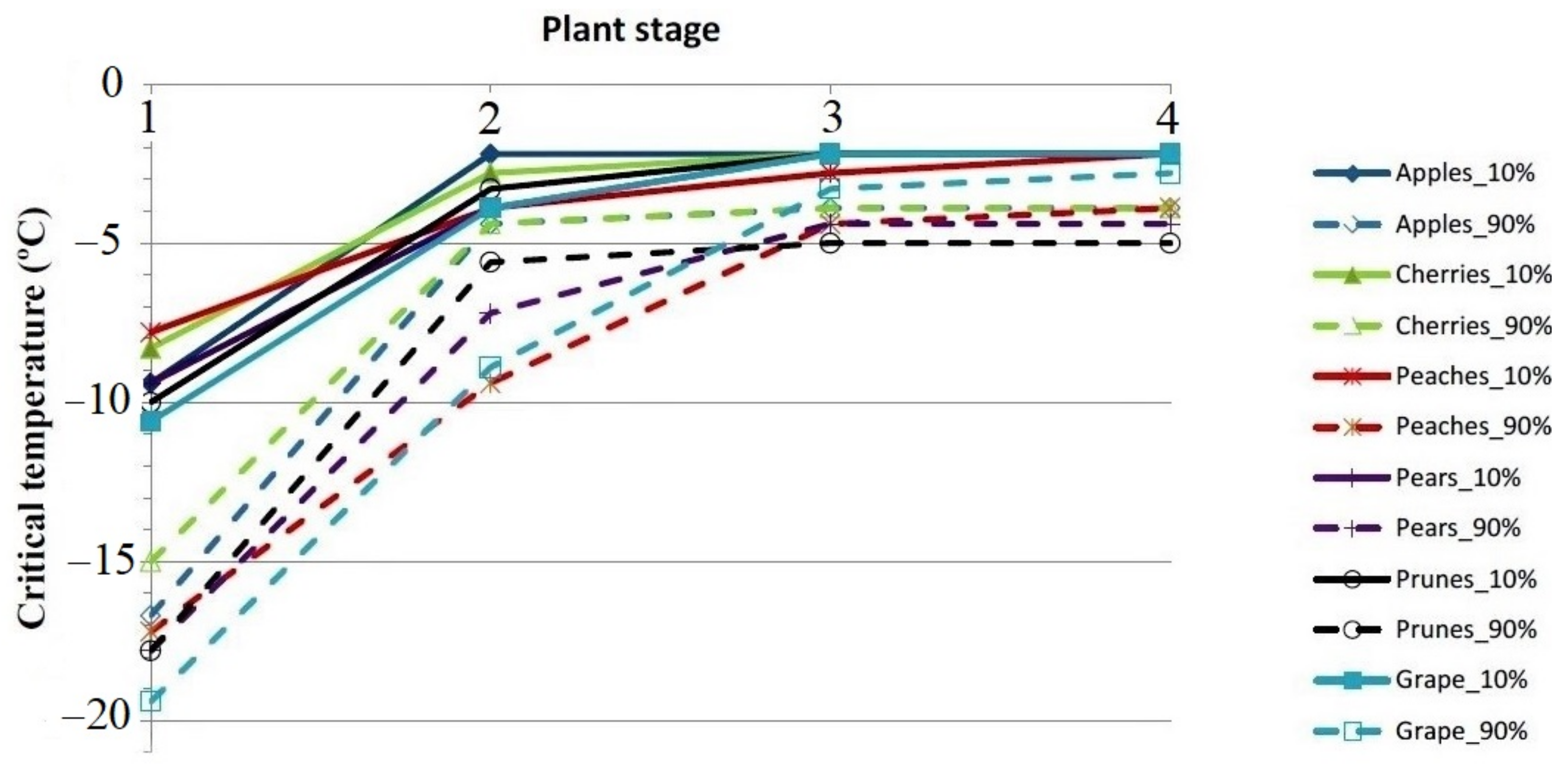
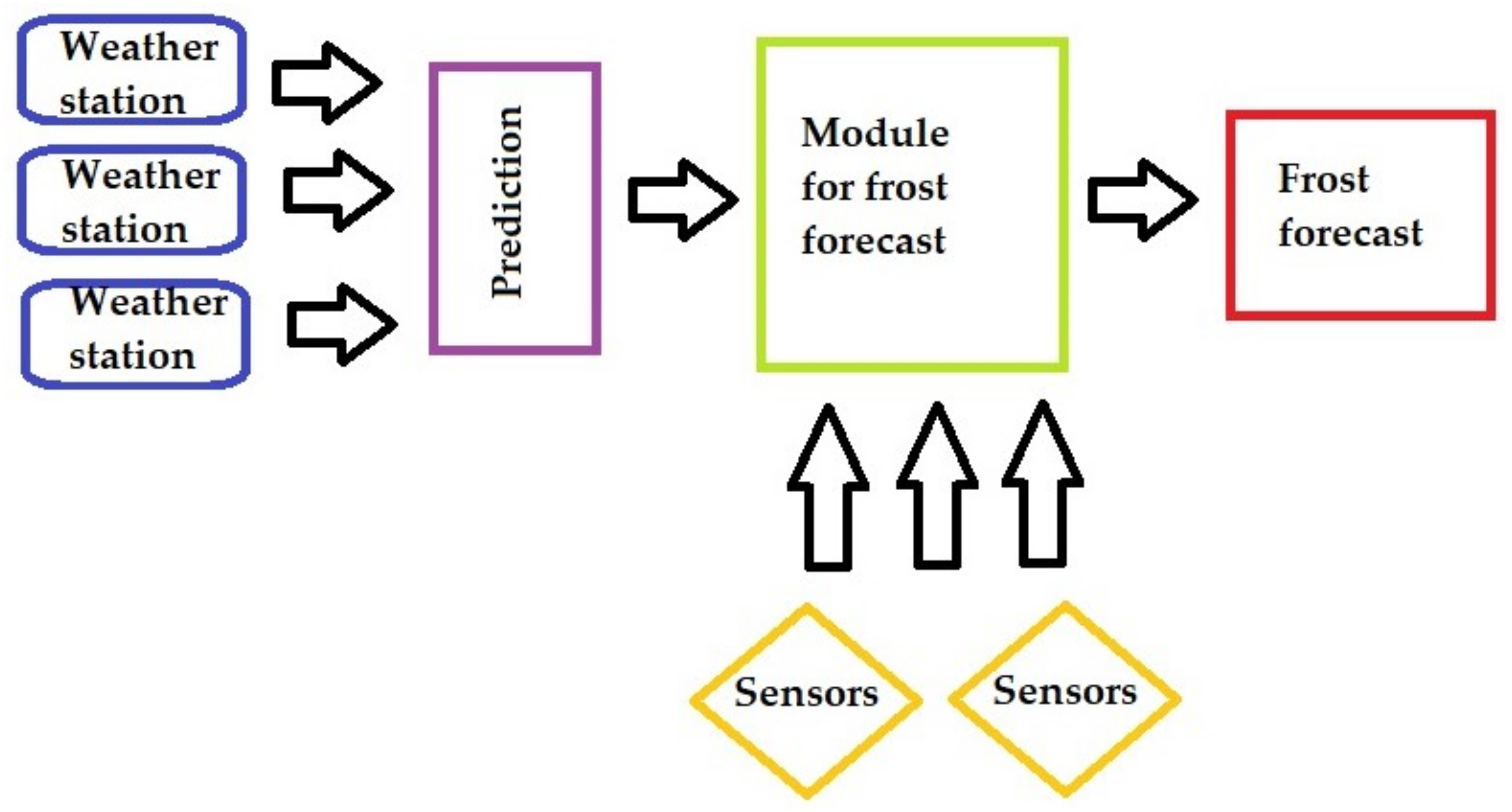
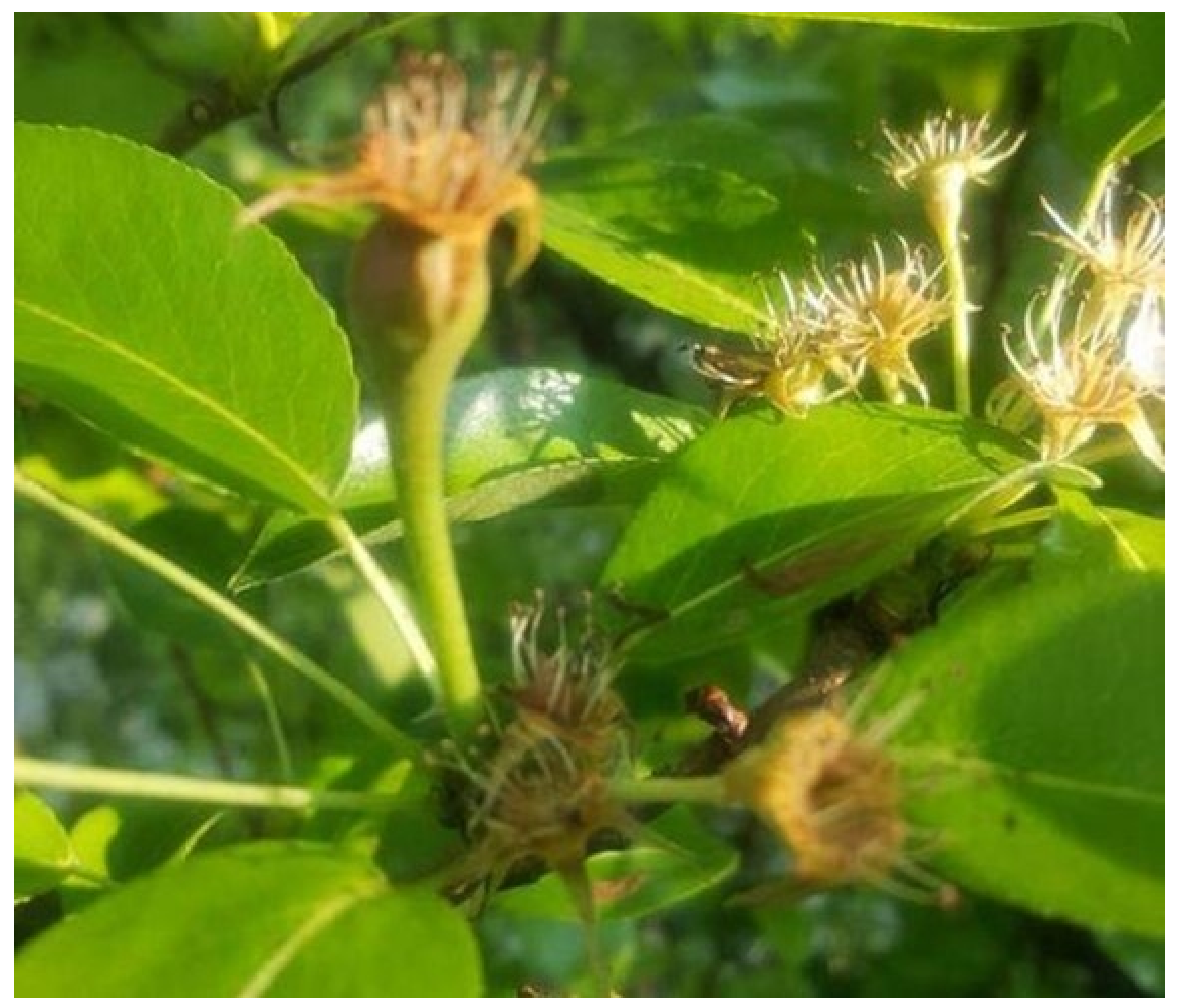
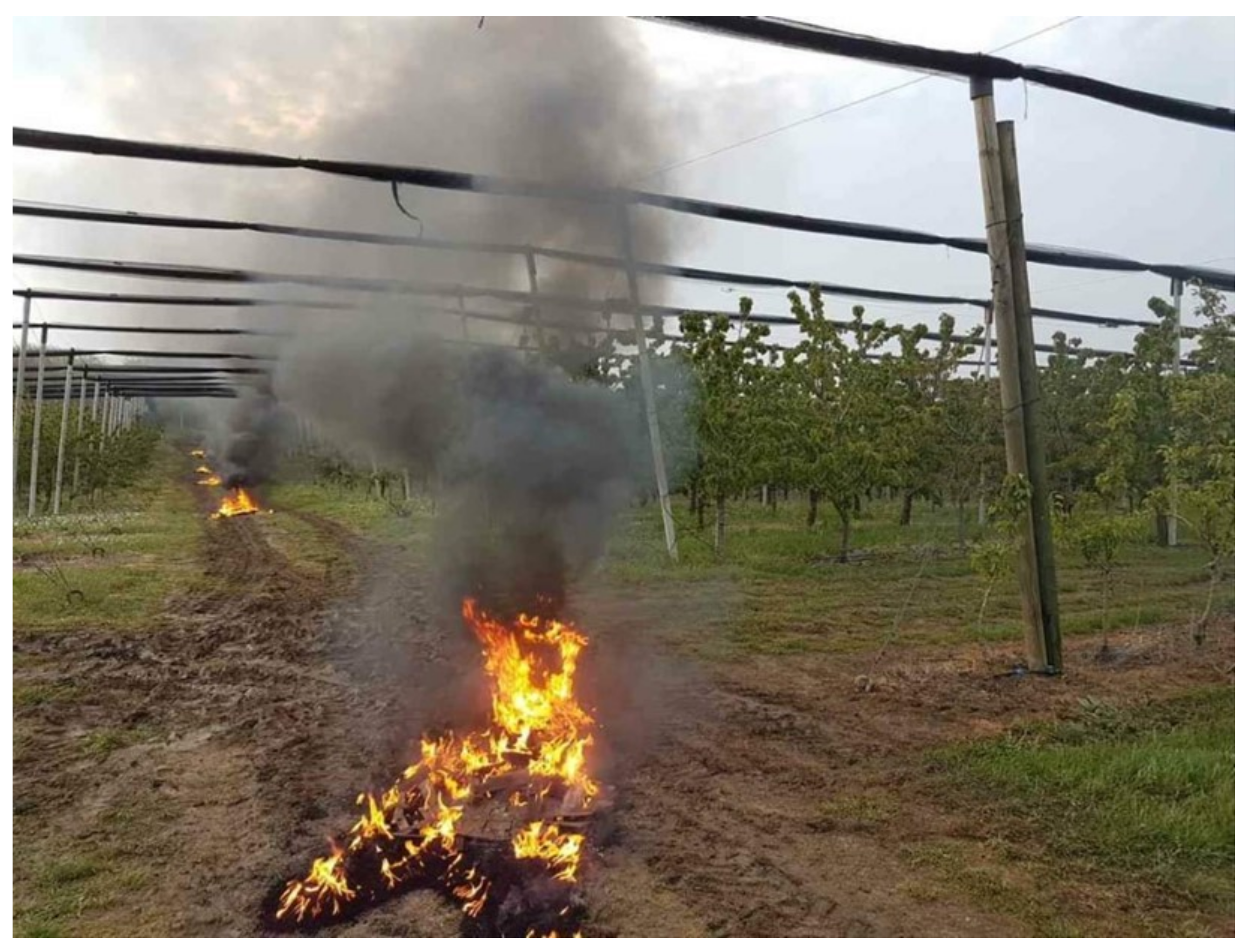

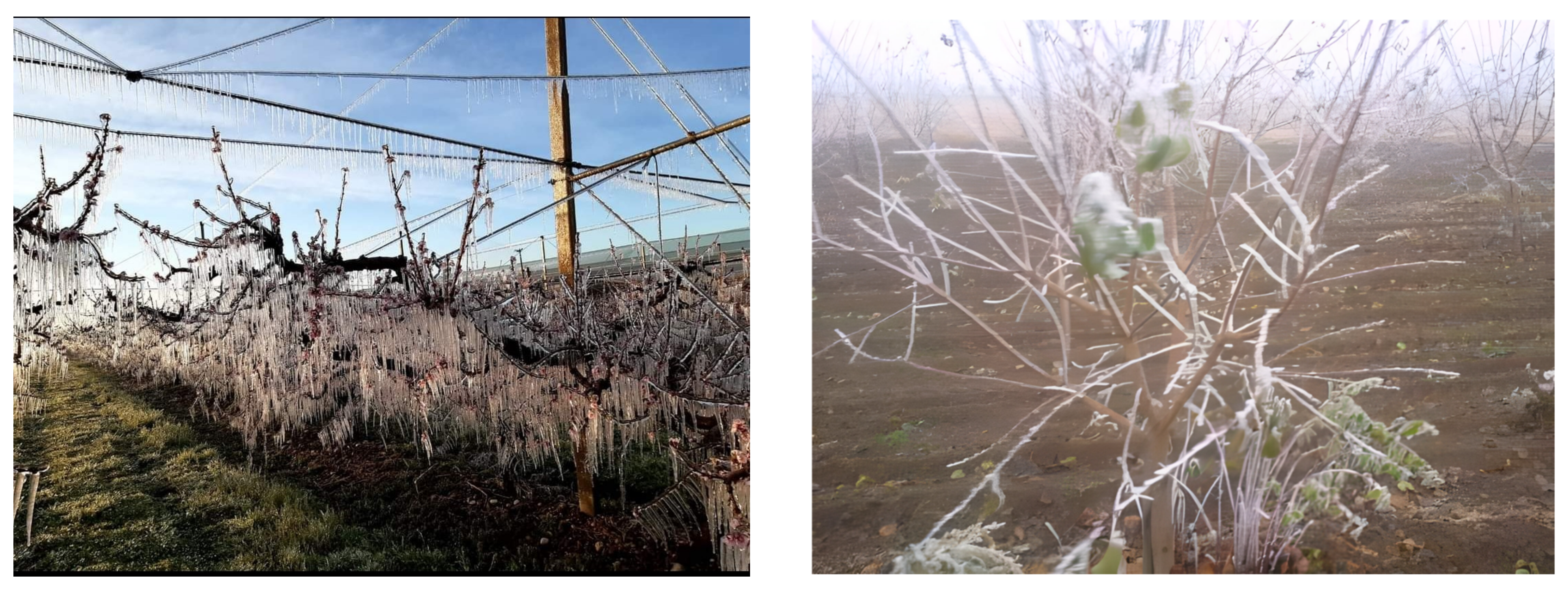
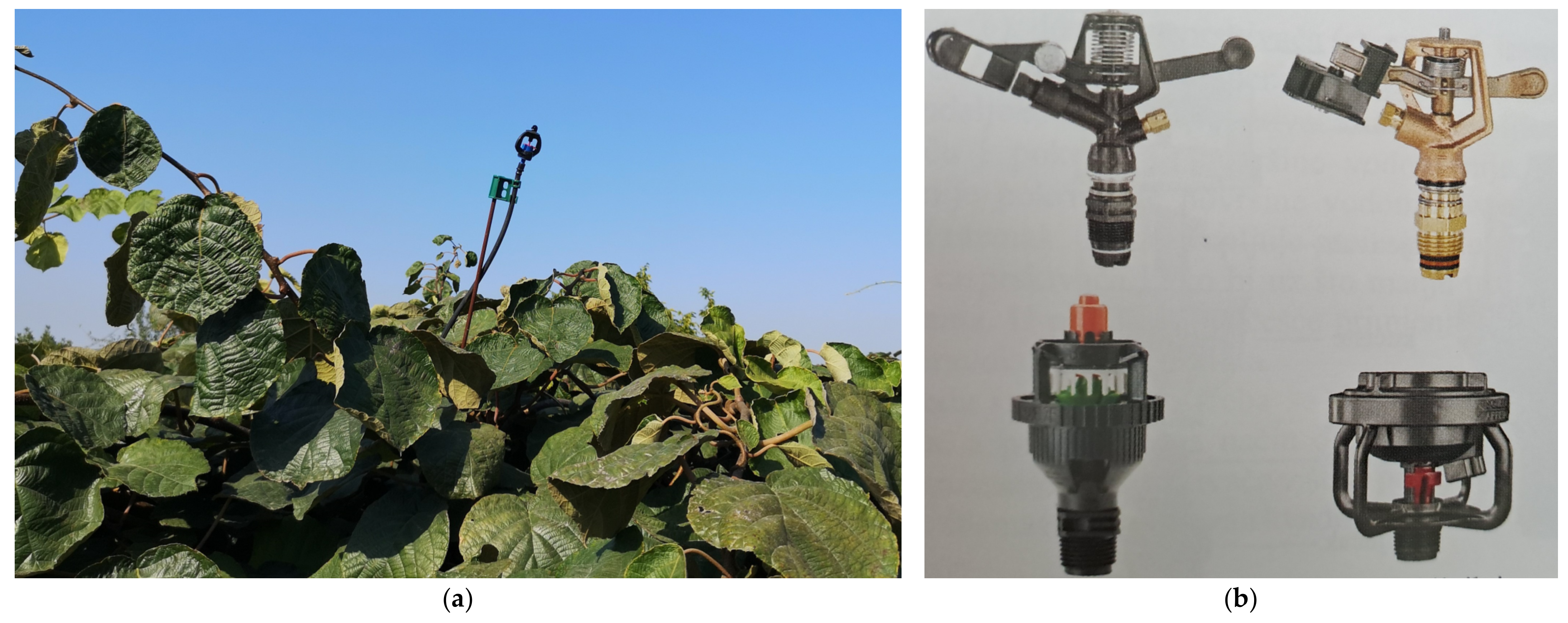


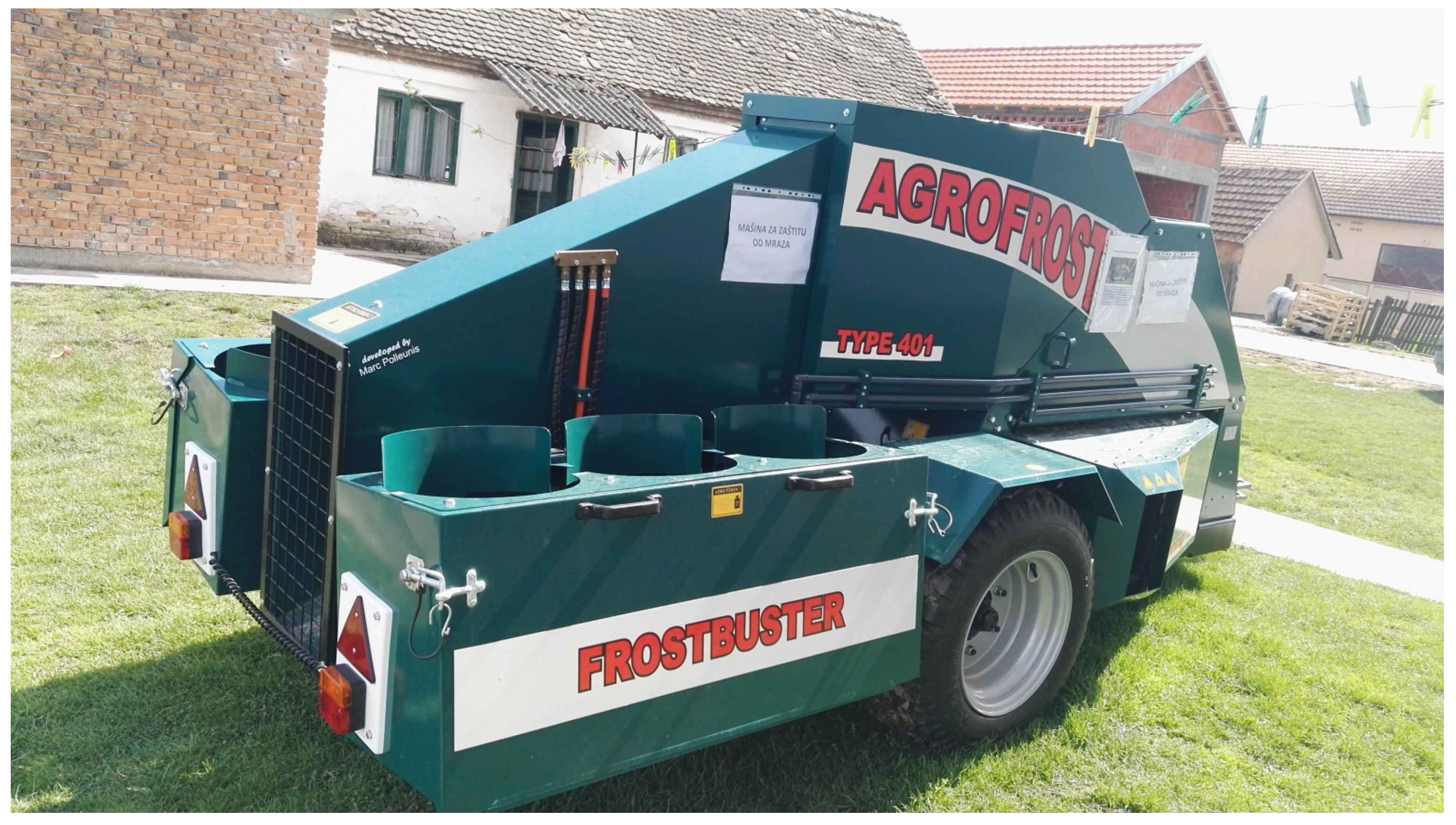



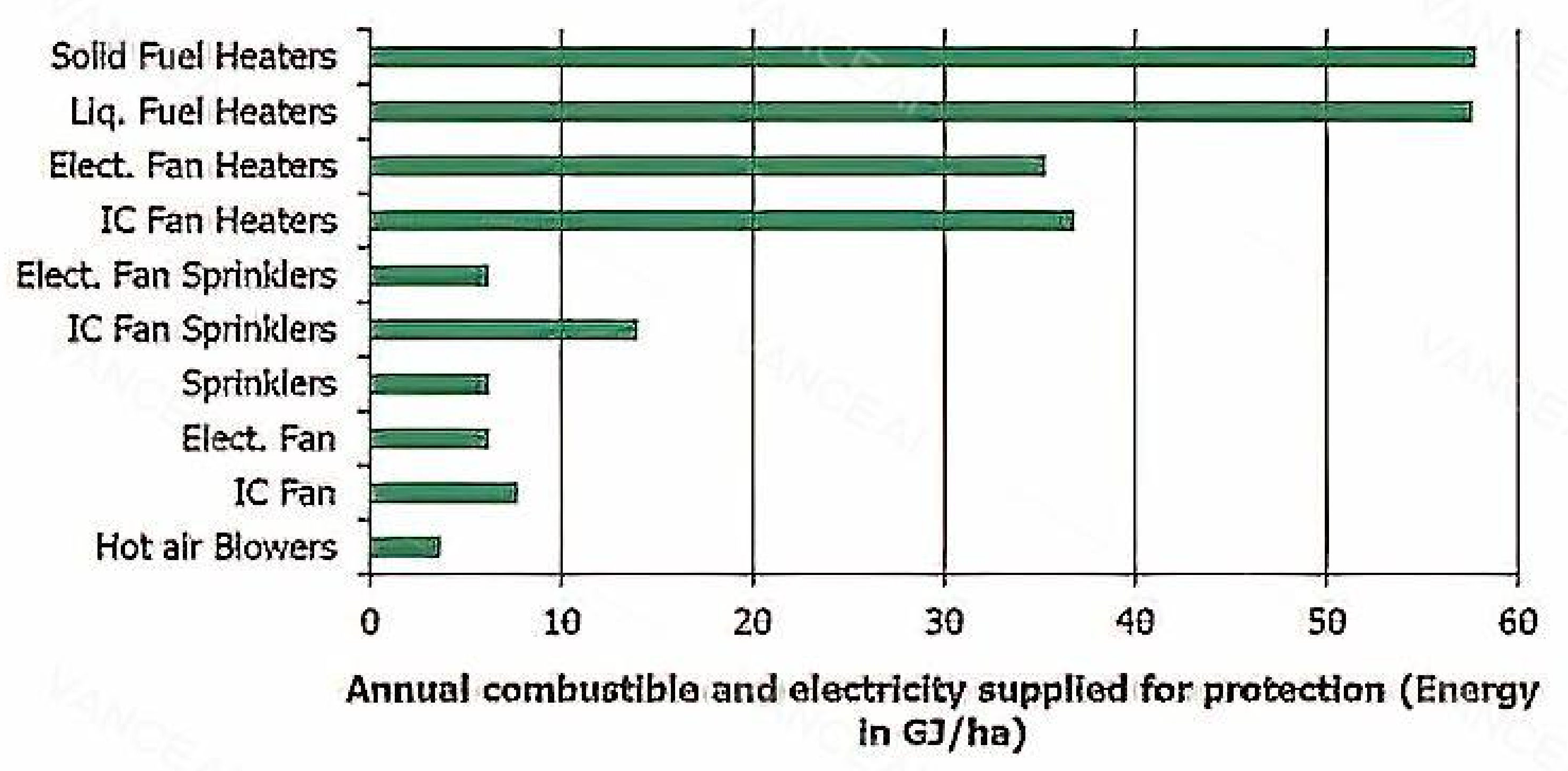
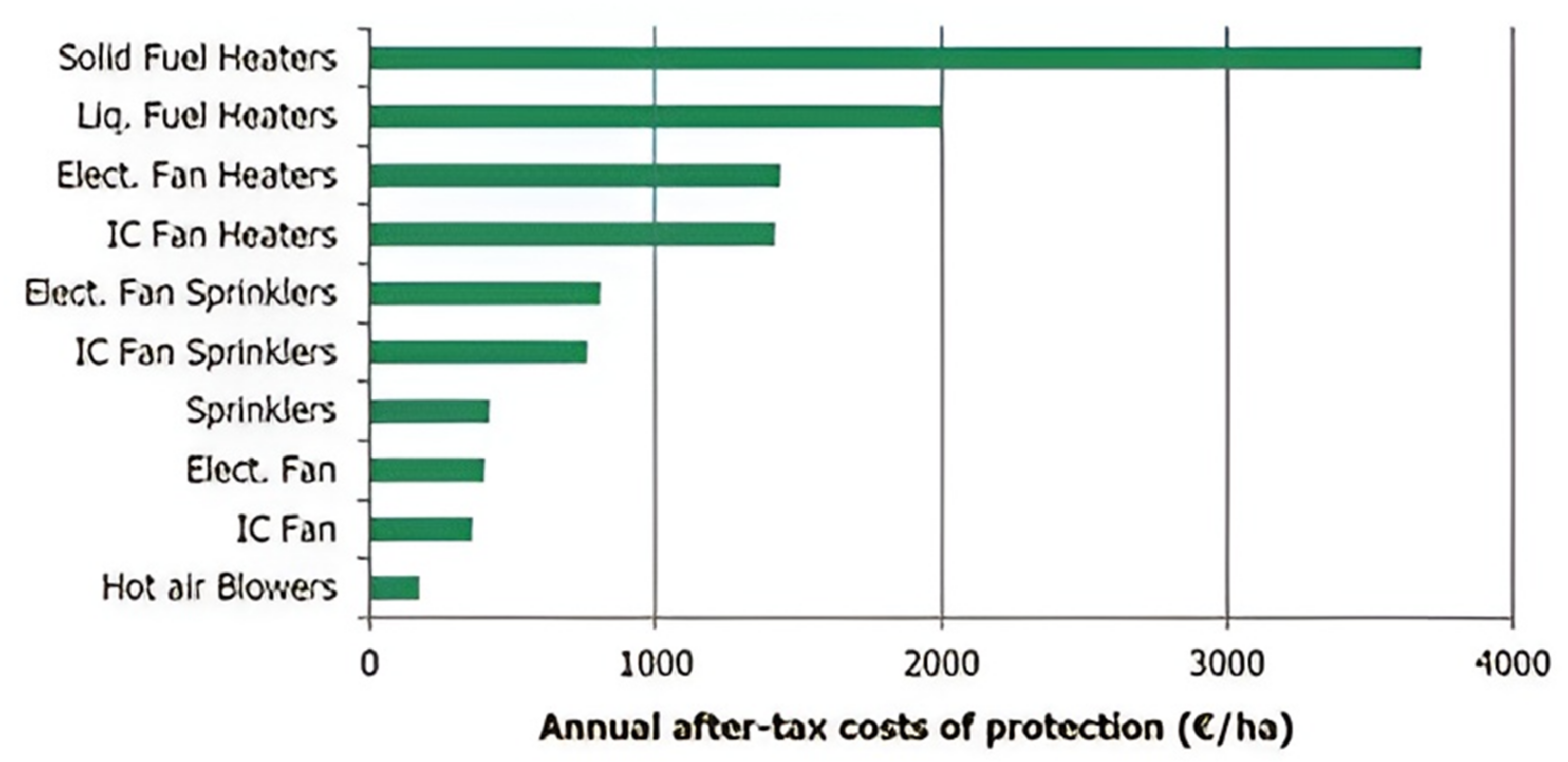
| Country of Study | Frost Observation | Bud/Flowering Observation | Time Period |
|---|---|---|---|
| Croatia | 7 times in March 3 times in April | 1899–2021 | |
| 8–9 times in March 4–5 days in April | 2008–2023 | ||
| USA, Illinois | Frost damage probability = 0.03 Frost damage probability = 0.21 | 1889–1979 1980–2012 | |
| Germany (south) | Frost damage to apple trees will increase by up to 10% compared to today with a 2 °C warming | 2006–2015 | |
| Czech Republic | Flowering period shifted to an earlier date: 13.9 to 8.1 days | 1924–2012 | |
| Europe (1000 locations) | Frequent cold spells overlapping with budding/flowering | Higher winter and early spring temperature = “false spring” | 1950–2013 |
| USA, California | Frost exposure decreased by 63% | 50–75% less frost hours for almond, avocado, and orange | to 2050 |
| Austria | Stable high-pressure systems are causing cold spells in spring | Flowering shifted to early April.—1.6 ± 0.9 days per decade. | The end of 21st century |
| Northern hemisphere (30° N) | ~43% of the hemisphere (mainly in Europe) = significant increase in frost days, mainly in spring | Lengthening of the growing season | 1982–2012 |
| Crop | Phenological Stages | 10% Kill | 90% Kill |
|---|---|---|---|
| Apples | Silver tip | −11.9 | −17.6 |
| Tight cluster | −3.9 | −7.9 | |
| First bloom | −2.3 | −4.7 | |
| Post bloom | −1.9 | −3.0 | |
| Apricots | Tip separates | −4.3 | −14.1 |
| First bloom | −4.3 | −10.1 | |
| Full bloom | −2.9 | −4.7 | |
| Green fruit | −2.3 | −3.3 | |
| Pears | Scales separate | −8.6 | −17.7 |
| First bloom | −3.2 | −6.9 | |
| Post bloom | −2.5 | −3.9 | |
| Prunes | First swell | −11.1 | −17.2 |
| Tip green | −8.1 | −14.8 | |
| First bloom | −4.3 | −6.9 | |
| Post bloom | −2.7 | −4.0 | |
| Grape | First swell | −10.6 | −19.4 |
| Bud burst | −3.9 | −8.9 | |
| First leaf | −2.8 | −6.1 | |
| Fourth leaf | −2.2 | −2.8 | |
| Citrus fruit | Green oranges Green lemons | −1.4 | −1.9 |
| Country of Study | Model | Properties | Description |
|---|---|---|---|
| Australia | TT—Thermal time | Spring temperatures determine flowering | Flowering shifted to September (South Hemisphere). Frost frequency decreases at +1 and +2 °C projections, while it is without risk at +3 °C. |
| SC-G—Sequential chill growth | Winter and spring temperatures determine flowering | Flowering remains within the range of historical observations with further warming. Frost conditions remain unchanged, indicating an initial increase in risk (+1 °C), but risk decreases with further warming (+2 °C). | |
| USA, South Georgia | WFR-ARW Adv. Res. Weather and Forecasting | Air, wet bulb, dew point temperatures, wind speed and direction | Applicability and accuracy of frost warnings for both advective and radiative frost scenarios. The accuracy of the minimum temperature prediction was over 90%. |
| France | Digital Elevation Model | Mapping of frost hazardous areas | Probability of frost in the projected area will increase significantly in the 21st century for two of the three phenological models. |
| Argentina | Theoretical–empirical model | Using active measures to reduce frost damage | Quantitative analysis of farmers’ decisions about required investment and operating costs for frost protection equipment. |
| Switzerland | Sion and Aigle model | Location and elevation importance for frost risk | Long-term prediction (2021–2050) for changes of phenology and frost risk. |
| Europe | UniChill | Future suitability for grape growing | Decrease in frost events in western regions (Spain and United Kingdom) and an increase in central Europe (Germany) |
| China | GCM—Global Climate Models | Prediction of bud breaking and flowering | Earlier apple flowering (2050–2090) by 0.04–0.14 d y−1 for budburst and 0.12–0.22 d y−1 for fruit set. Frost frequency will decrease by 0.09–0.36 d, but frost intensity will increase by 0.004–0.008 °C d−1. |
| Belgium | Climate model for RCP 4.5 and RCP 8.5 scenarios | Prediction of flowering time | Earlier pear flowering started on average 7.5 (10.8) days earlier under the RCP 4.5 (8.5) scenarios. Frost occurrence on average 12.8 (17.9) days earlier in 2019–2068 compared to 1971–2018. |
| Hardware | Model | Specifications |
|---|---|---|
| UAV (DJI Ltd., Shenzhen, China) | DJI Matrice 600 Pro (with TB47S batteries) | 6 kg payload, 16 to 32 min hovering time, ±0.5 m vertical and ±1.5 m horizontal hovering accuracy |
| Thermal camera | DJI Zenmuse XT2 (with a 19 mm lens) | −25 to 135 °C scene range, 7.5 to 13.5 µm spectral range, 32° × 26° FOV, 640 × 512 resolution |
| RGB camera | DJI Zenmuse Z30 | 30 × optical zoom, 63.7° × 38.52° wide-end FOV, 2.3° × 1.29° tele-end FOV, 1920 × 1080 resolution |
| Tissue Temperature (°C) | Wind Speed (km h−1) | ||||
|---|---|---|---|---|---|
| 0–1.5 | 3–6.5 | 8–13 | 15–22 | 29–32 | |
| −3 | 0.25 | 0.25 | 0.36 | 0.50 | 1.00 |
| −4 | 0.25 | 0.40 | 0.75 | 1.00 | 2.00 |
| −5 | 0.30 | 0.60 | 1.25 | 1.50 | 3.00 |
| −6 | 0.35 | 0.70 | 1.40 | 1.80 | 3.65 |
| −7 | 0.40 | 0.75 | 1.50 | 2.00 | 4.00 |
| Method | Principle | Applicability | Positive | Negative |
|---|---|---|---|---|
| Smoking | A subdued fire on a low-burning material produces a lot of smoke (manure, sawdust, or wet straw mixed with leaves) | Smaller, less intensive Plantations. Relatively effective on lower intensity radiation frosts. | Provides a high fraction of radiant energy that is absorbed by the plants. Relatively low costs. | Smoke particles are too small to absorb terrestrial radiation. The surrounding wind carries the smoke away from the plantations, as well as low air pressure. Ecology is questionable. |
| Over-tree sprinkling | Heat is released when water freezes (80 cal/L gram of water). The ice actually becomes an insulator between the plant parts and the ambient temperature below 0 °C. | Frost protection down to −7 °C. Start and stop are dependent on the ice properties. | For any type of radiative and evaporation frost. Partially effective for advection frosts. | High installation costs. Severe damage can occur if the sprinkler system fails. The weight of the ice that forms may break limbs and cause the loss of scaffolds in trees of some species. |
| Under-tree microsprinkling | Same principles as overhead sprinkling apply. Water under trees = less water consumption. | Effective on any form of radiation and evaporation frost. For any plantation size. | The possibility of subcooling plant parts. The ice is likely to cool more than if the water is concentrated in a smaller area. | |
| Direct heating—stationary stoves; mobile generators | Combustion of fossil fuels, whose radiation energy is spread horizontally across the plantation | Effective on any form of radiation and evaporation frost. For smaller and medium-size plantations. | High amount of radiant energy that is absorbed by the plants. Effective for radiative and evaporation frosts. | Installation costs are high. Energy consumption is low. Area coverage is limited. |
| Large diameter fans | Classic wind axial fans consist of a steel tower with large rotating blades (3–6 m in diameter). Axis tilted up to 7° to the plantation. | Area coverage is from 4–6 ha. Ideal placement of the fan depends upon the airflow on frost nights. | For stronger radiative frosts. Mixing of great amounts of the air. Auto-starting systems connected with a weather station. | Minimum temperatures that are likely to occur should not be more than 2 °C lower than the critical damage temperature. Installation costs are high, but operational costs are moderate. |
| Upward fans | Wind machines that blow vertically upwards. The fan will pull in cold, dense air near the ground and blow it upwards, where it can mix with warmer air. | Area coverage is smaller than for the classical fans (1–2 ha). Relatively effective on lower-intensity radiative frosts. | Low energy consumption. Relatively effective for lower-intensity radiative frosts. | Only a temporary, positive effect near the fan. Installation costs are high. |
| Unmanned helicopters | Move warm air from aloft in a temperature inversion to the colder surface. | The area coverage depends on the helicopter size, weight, and weather conditions. | Operational costs are unaffordable for most growers. | Recommendations on pass frequency vary between 30 to 60 min. If the control of temperature is not appropriate, serious damage occurs. |
| Probability of Frost Damage (%) | 10 Year Average Net Returns ($ ha−1) | Difference in Average Net Returns | ||
|---|---|---|---|---|
| Vineyard with Wind Machine | Vineyard without Wind Machine | $ ha−1 | $/4 ha Vineyard | |
| 0 | 1984 | 2711 | −726 | −7264 |
| 10 | 1928 | 2068 | −140 | −1410 |
| 20 | 1872 | 1426 | 446 | 4463 |
| 30 | 1838 | 783 | 1033 | 10,327 |
| 40 | 1760 | 141 | 1619 | 16,191 |
| 50 | 1704 | −502 | 2206 | 22,055 |
| 60 | 1648 | −1144 | 2792 | 27,919 |
| 70 | 1592 | −1786 | 3378 | 33,783 |
| 80 | 1536 | −2318 | 3965 | 39,647 |
| 90 | 1480 | 3071 | 4551 | 45,511 |
| 100 | 1424 | −3714 | 5137 | 51,375 |
Disclaimer/Publisher’s Note: The statements, opinions and data contained in all publications are solely those of the individual author(s) and contributor(s) and not of MDPI and/or the editor(s). MDPI and/or the editor(s) disclaim responsibility for any injury to people or property resulting from any ideas, methods, instructions or products referred to in the content. |
© 2023 by the authors. Licensee MDPI, Basel, Switzerland. This article is an open access article distributed under the terms and conditions of the Creative Commons Attribution (CC BY) license (https://creativecommons.org/licenses/by/4.0/).
Share and Cite
Tadić, V.; Gligorević, K.; Mileusnić, Z.; Miodragović, R.; Hajmiler, M.; Radočaj, D. Agricultural Engineering Technologies in the Control of Frost Damage in Permanent Plantations. AgriEngineering 2023, 5, 2079-2111. https://doi.org/10.3390/agriengineering5040128
Tadić V, Gligorević K, Mileusnić Z, Miodragović R, Hajmiler M, Radočaj D. Agricultural Engineering Technologies in the Control of Frost Damage in Permanent Plantations. AgriEngineering. 2023; 5(4):2079-2111. https://doi.org/10.3390/agriengineering5040128
Chicago/Turabian StyleTadić, Vjekoslav, Kosta Gligorević, Zoran Mileusnić, Rajko Miodragović, Marko Hajmiler, and Dorijan Radočaj. 2023. "Agricultural Engineering Technologies in the Control of Frost Damage in Permanent Plantations" AgriEngineering 5, no. 4: 2079-2111. https://doi.org/10.3390/agriengineering5040128
APA StyleTadić, V., Gligorević, K., Mileusnić, Z., Miodragović, R., Hajmiler, M., & Radočaj, D. (2023). Agricultural Engineering Technologies in the Control of Frost Damage in Permanent Plantations. AgriEngineering, 5(4), 2079-2111. https://doi.org/10.3390/agriengineering5040128








